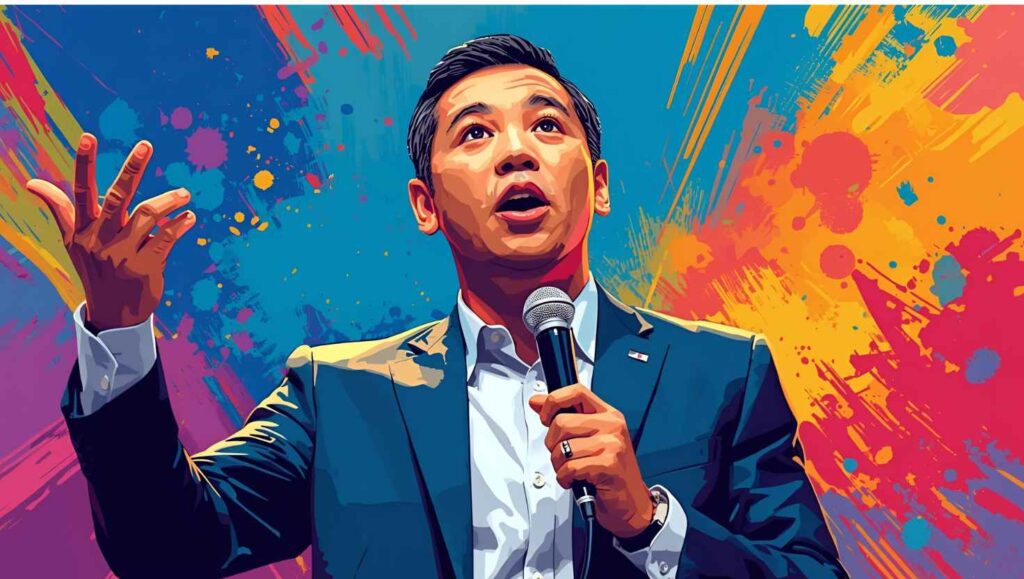Not long ago, a client called me with a simple but important question: “Sir Jef, should we fly you in for our company event, or can you just do it virtually?”
That question would have surprised me years ago. Before the pandemic, most motivational speaking in the Philippines was face-to-face. Events meant people gathering in a hall, shaking hands, laughing together, and sharing energy in the same room. But when COVID-19 arrived, everything shifted online. Companies discovered the convenience of Zoom, and suddenly “virtual” wasn’t just an option—it was the only way.
Now that we can meet again in person, the question lingers: What works best—virtual or face-to-face motivational speaking?
The truth is, both have value. Face-to-face brings presence that no screen can replace. Virtual brings accessibility and reach. The best choice isn’t about which one is universally better—it’s about what your people need at a given time.
The Power of Face-to-Face Presence
Motivation spreads through presence.
I still remember one leadership talk I gave in a packed conference hall. I told my story about earning only ₱6,000 a month as a young teacher, feeling stuck and unsure of the future. As I spoke, the room grew quiet. You could hear the shift—people leaning in, some holding their breath. When I paused, the silence was alive, heavy with meaning. And when the story turned toward hope, the room exhaled together, laughter and nods breaking the tension.
That’s the power of presence.
Face-to-face speaking allows for connection that isn’t filtered by screens. Motivation isn’t just in the words—it’s in the eye contact, the pauses, the shared laughter, even the nervous energy in the room. Science calls it “emotional contagion”—we catch each other’s emotions through subtle cues, and mirror neurons in our brains fire when we see others express joy, courage, or vulnerability.
In Filipino culture, this presence matters even more. Values like pakikipagkapwa (shared identity) and malasakit (genuine care) are best felt in person. When a speaker shows up, stands before the people, and speaks from the heart, it sends a message beyond words: “I am here with you. I care.”
That’s why face-to-face talks often create deeper, more lasting memories. People don’t just hear stories—they experience them together.
The Reach of Virtual Speaking
Technology expands access.
During the pandemic, I delivered a virtual workshop to employees scattered across Luzon, Visayas, and Mindanao. Some were at home, others in small offices, a few even connected on their phones while commuting. In the old days, gathering them in one hall would have meant huge travel costs and weeks of planning. That day, with one link, everyone showed up.
That’s the strength of virtual motivational speaking: accessibility.
Virtual makes it possible for companies to inspire people no matter where they are—whether it’s a team in Metro Manila, a branch office in Davao, or even overseas Filipino workers in Dubai. It saves on logistics, cuts costs, and allows leaders to bring in voices they otherwise couldn’t afford to fly in.
And in a Filipino context, where families are often separated by geography and work, virtual platforms create bridges. They allow motivation to reach people who would otherwise be left out.
But while virtual has reach, it has limits too. The laughter is quieter. The silences don’t carry the same weight. The spark can still happen, but it takes more intentional design—engagement tools, storytelling, and interaction—to make people feel connected through a screen.
Table: Virtual vs. Face-to-Face Motivational Speaking
| Aspect | Face-to-Face | Virtual |
|---|---|---|
| Presence & Energy | Strong—eye contact, shared silence, contagious laughter | Limited—filtered through screens, harder to sustain |
| Accessibility | Restricted by venue, travel, and budget | Wide reach—anyone with internet can join |
| Cost | Higher—logistics, travel, accommodations | Lower—no flights or venues needed |
| Cultural Resonance | Strong—Filipino values embodied in person (kapwa, malasakit) | Possible, but requires intentional design |
| Lasting Impact | Deep—emotional memory and collective experience | Broad—scalable, repeatable, good for follow-ups |
Both have a place. Face-to-face is unmatched for deep, emotional connection. Virtual is unbeatable for scale and accessibility. The question isn’t “which is better?”—it’s “what do you need right now?”

Why Presence Still Matters Most for Motivation
Motivation is not just information. If it were, people could simply watch YouTube videos and change overnight. But lasting motivation is about energy, identity, and connection—things that are harder to transmit through a screen.
I’ve seen this firsthand. When I tell my story of earning only ₱6,000 a month as a young teacher in a live room, the silence is powerful. People lean in, some nodding, others wiping tears. You can feel the weight of the story ripple through the audience.
But when I told the same story virtually, the reaction was different. Some typed “So inspiring!” in the chat. A few turned their cameras on to clap. It was good—but it wasn’t the same. The silence wasn’t shared. The energy wasn’t collective.
That’s the difference presence makes. In Filipino culture especially, where pakikipagkapwa (shared identity) and malasakit (genuine care) are deeply felt values, physical presence strengthens the bond between speaker and audience. It shows, “I am with you. I am here.”
Face-to-face speaking plants memories in the heart. People don’t just remember the words—they remember how it felt to be in that room.
When Virtual Works Best
That doesn’t mean virtual is weak. It has its own strengths—especially when the goal is reach and continuity.
Virtual motivational speaking works best when:
- Teams are geographically dispersed. A nationwide company can gather people from Manila, Cebu, and Davao in one session without travel costs.
- Follow-ups are needed. After a powerful face-to-face keynote, virtual sessions help sustain the spark.
- Budgets are tight. Virtual eliminates flights, hotels, and venue rentals, making it cost-effective.
- Urgency matters. If a team needs a quick motivational boost before a big project, virtual can deliver it in days, not months.
I worked with one company that faced this choice. For their product launch, they used a virtual keynote to include hundreds of employees across the country. But for their year-end summit, they flew me in. Why? Because they wanted that emotional spark—the kind of energy that only face-to-face presence can bring.
The lesson is clear: use virtual for accessibility and scale, but lean on face-to-face when you need deep, cultural, emotional resonance.
And sometimes, the best answer isn’t choosing one or the other—it’s blending them to get the strengths of both. Let’s look at how that works.
Blended Approaches: The Best of Both Worlds
Sometimes the best question isn’t “Which one is better?” but “How do we combine them?”
Face-to-face and virtual are not enemies—they’re partners. Used together, they create both the spark and the sustain.
I often design programs this way:
- Start with face-to-face. A live keynote to spark energy, shift perspectives, and create shared memories.
- Follow with virtual. Short online sessions to sustain the shift, answer questions, and guide application.
This approach works especially well in Filipino workplaces. People need the pakikipagkapwa presence of a live event to feel bonded, but they also benefit from the accessibility of virtual sessions to keep momentum alive.
Think of it this way: spark the fire in person, keep it burning with virtual.
FAQ: Virtual vs. Face-to-Face Speaking
Q1. Is face-to-face always better?
Not always. Face-to-face is unmatched for deep emotional impact. But virtual works better when scale, speed, or budget are priorities. The best choice depends on your goal.
Q2. Can virtual talks really motivate people?
Yes—if designed well. Virtual talks need interaction, stories, and reflection, not just slides. While they may not match the intensity of live presence, they can still spark shifts across wide audiences.
Q3. Which one costs more—and why?
Face-to-face usually costs more due to travel, accommodations, and venues. Virtual is more cost-effective. But don’t measure cost by pesos alone—measure it by the value of the shift created.
Q4. How do I decide what’s right for my team?
Ask three questions:
- Do we need connection (go face-to-face)?
- Do we need reach (go virtual)?
- Do we need both spark and sustain (blend the two)?
At the end of the day, the question isn’t really about technology or tradition. It’s about your people—and what kind of shift they need most right now. Let’s close with that.
Choosing What Works Best for Your People
When that client asked me, “Sir Jef, should we fly you in or just do it virtually?” I told her the truth: It depends on what your people need.
If the goal is deep connection, where silence, laughter, and presence create lasting memories, then face-to-face is worth every peso. If the goal is broad reach and accessibility, where teams across the Philippines or the world can join together, then virtual is the better choice.
And if the goal is both spark and sustain—the fire of presence and the continuity of technology—then blend them. Use face-to-face to ignite, and virtual to keep the flame alive.
There’s no one-size-fits-all. What matters most is clarity: knowing the shift you want for your people. Because in the end, motivational speaking is not about the platform. It’s about the transformation it creates.
If you’re looking for a motivational speaker in the Philippines who can design shifts—whether face-to-face, virtual, or both—you can start here: Motivational Speaker Philippines.
Because the real question isn’t whether the talk is onstage or on-screen. The real question is: Will it move your people?
